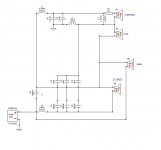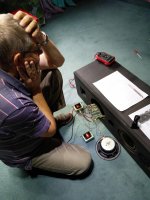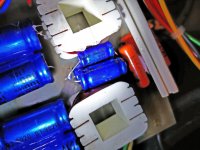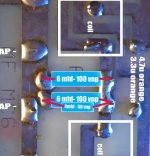Not sure what you mean by completely bypassing the x-overs but you could in theory run cables directly
from one set of terminals to the bass drivers piggy back to the mids with a simple filter and drive with one amp then do the same on the tweeters via a second set of terminals and another simple filter driven by the other amp. This is as basic as frequency splitting gets and finding the values needed would be difficult plus using such a simple method introduces other issues like overlap etc.
It's probably best to do as chris suggests and leave them as they are , x-overs are complicated and difficult to get right . If you are determined to go the bi -amp route maybe sell the speakers and source a bi -wire enabled pair either the MF 's you mentioned initially or a different brand .
You didn't say which amps you have btw ?
from one set of terminals to the bass drivers piggy back to the mids with a simple filter and drive with one amp then do the same on the tweeters via a second set of terminals and another simple filter driven by the other amp. This is as basic as frequency splitting gets and finding the values needed would be difficult plus using such a simple method introduces other issues like overlap etc.
It's probably best to do as chris suggests and leave them as they are , x-overs are complicated and difficult to get right . If you are determined to go the bi -amp route maybe sell the speakers and source a bi -wire enabled pair either the MF 's you mentioned initially or a different brand .
You didn't say which amps you have btw ?
Mario: note that some of the latest few generations of multichannel (i.e. Home theatre) receivers actually include the ability to provide true digital XO and bi-amping of front main speakers via the onboard DSP and assignment of amp channels not used for surround effects channels (usually front height or width) I have an Onkyo that does exactly that.
They include the ability but the benefit is arguable. They have a shared PS and it is usually designed by the company accountant so even if they feature separate power amp sections (most I have opened do not but have a newer Denon X2000 which may fiddle with), they`d provide close to zero benefit, especially when a passive crossover is present upfront (about 99.99% of the case).
Fair enough comment, although while I haven't yet played with it further than just using the internal amp stages, I'd imagine that the line outs would share that band passing feature - which should glean the desired benefits, no?
As for PS being "designed by the company accountant(s)" - I think maybe you mean the budget is subject to review by them, not so much actually "engineered" by the financial department? 😀
As for PS being "designed by the company accountant(s)" - I think maybe you mean the budget is subject to review by them, not so much actually "engineered" by the financial department? 😀
I've got it almost drawn out into a schematic, but it's an unusual arrangement. I seem to be getting something wrong, so need to trace it down.
From the looks of it, this will not be easy to split into separate sections. Unless I'm just not seeing it right.
From the looks of it, this will not be easy to split into separate sections. Unless I'm just not seeing it right.
Thanks guys for all your advice and concerns ! A friend popped round and had a look and confessed that this was the most baffling x-over he had ever come across... Also he too thought there had been some tampering made by a previous owner. I am of the inclination that these are not only an early pair but might well be a prototype / demo pair.
Bi-amping is a nice bonus if achievable, but hardly straightforward with this particular pair, perhaps will prove too much hassle in the end and will have to abort.
Can confirm the speakers are a four way design.
The two stereo amplifiers I was intent on getting off of a friend are no longer available (Alchemist Odin 2x100w) so will source something else
Bi-amping is a nice bonus if achievable, but hardly straightforward with this particular pair, perhaps will prove too much hassle in the end and will have to abort.
Can confirm the speakers are a four way design.
The two stereo amplifiers I was intent on getting off of a friend are no longer available (Alchemist Odin 2x100w) so will source something else
Attachments
Many thanks for that, really interesting
I think this is it. Kinda funky, so not sure if it's totally correct.
Ignore the inductor values, we don't know what they are. Also, tweeters and mids are simply connected in parallel front and back. Not shown here.
While you are on the look out for suitable equipment one thing worth a mention with regards to bi-amping .
You don't have to buy matched amps necessarily , some people " fine tune " by driving HF with one brand/ type and a different model for the LF 's . If you really want to hear the improvements that bi-amping can bring and funds allow consider some active x-overs .
You don't have to buy matched amps necessarily , some people " fine tune " by driving HF with one brand/ type and a different model for the LF 's . If you really want to hear the improvements that bi-amping can bring and funds allow consider some active x-overs .
It's the perfect photo of trying to figure out this crossover. 😀
It's unusual, to say the least.
It's unusual, to say the least.
Hi Pano,
Maybe a miss-wired attempt at a series crossover? There has to be a dc-path to the woofers, and here there is none. It may well be best to start over?
Regards,
Maybe a miss-wired attempt at a series crossover? There has to be a dc-path to the woofers, and here there is none. It may well be best to start over?
Regards,
I know, it's really odd. Looks like everything is high passed. I find that odd and hard to believe. Could be I traced it wrong, but I spent a fair amount of time on it. It did not make much sense. If someone wants to take the time to double check me, I would be very happy.
Hi chrisb, I have tried upgrading the caps on a few speakers from the 1980s before without any noticeable improvement. Rewirering seemed to have the most effect, perhaps that's the re-soldered joints ?
upgrading the BPE (bipolar electrolytics) for low voltage poly film caps of equal value. Note that those types can be substantially physically larger than the BPEs.
Seems OK 😉 It's unusual.If someone wants to take the time to double check me, I would be very happy.
There is, but you have to go through all four inductors.There has to be a dc-path to the woofers,
Ignoring the midrange and tweeter drivers and the two smaller capacitors, the midwoofers use the three inductors near the tweeter plus the first 100uF as a second order low pass. The woofers cascade from these using the additional coil and electros.
The mids and tweeters are strung across those three coils in what appears to be a second order bandpass and second order highpass. This string finds its feed by bypassing the woofers through the first electro, and one tweeter seems to use the resistor while the other (rear) doesn't.
Last edited:
The rear mids and tweeters are connected with opposite polarity to the fronts, though it's likely there would be a dipolar radiation pattern either way due to the baffle, and these are here primarily for ambience as shown by the higher output of the rear tweeter.dipole
The midwoofers revert to a bipole, same polarity, probably to reduce diffraction and simulate an infinite baffle, removing the baffle step. The placement of the woofers would probably then be relatively unimportant.
Hi chrisb, I have tried upgrading the caps on a few speakers from the 1980s before without any noticeable improvement. Rewirering seemed to have the most effect, perhaps that's the re-soldered joints ?
I have recently serviced a pair of KEF Concerto speakers from the 70's
They have bipolar caps in the crossover.
Some of the caps were out of spec when measured so needed replacement.
I also replaced some of the smaller bipolar caps with plastic types. This did make the speaker sound a bit brighter. The plastic caps have a smaller internal resistance which can be significant.
Its hard to be completely sure what effect the new caps had, as the crossovers were definitely not working correctly before I serviced them. The speakers sound much better anyway!
Ahhh the KEF Concertos, my first pair of proper speakers when a teen in the 70s ! Mine were a KEF Kit version and build the cabinets in woodwork at school 🙂
I have recently serviced a pair of KEF Concerto speakers from the 70's
They have bipolar caps in the crossover.
Some of the caps were out of spec when measured so needed replacement.
I also replaced some of the smaller bipolar caps with plastic types. This did make the speaker sound a bit brighter. The plastic caps have a smaller internal resistance which can be significant.
Its hard to be completely sure what effect the new caps had, as the crossovers were definitely not working correctly before I serviced them. The speakers sound much better anyway!
- Status
- Not open for further replies.
- Home
- Loudspeakers
- Multi-Way
- How to make my speakers bi-wire-able ?



